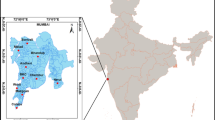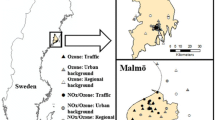Abstract
The relationships between ozone (O3) and its precursors, nitrogen oxides (NO x ) and volatile organic compounds (VOCs), were investigated in the VIR region (34° 10′ S, 71° 36′ W), referred to as Libertador General Bernardo O’Higgins of Chile. Observations were obtained from a field study performed at four monitoring sites, which represented different environmental conditions, i.e., rural-coastal (Marchihue, MA), urban (Rancagua, RA, and Rengo, RE), and semi-urban (Codegua, CO) during the summer (between Feb 1 and Mar 12, 2010). Overall, greater O3 concentrations were identified at the urban sites compared with the semi-urban and rural sites. In addition, the O3 precursor concentrations were high in the early morning hours as a consequence of fresh vehicular emissions (from 11 to 40 ppbv for NO x and from 15 to 36 ppbC for VOC). The total VOC/NO x ratios at the study sites indicated that the formation of O3 was limited by VOCs. Most O3 was formed from ethene, isoprene, propene, 2-methylpropene, m- and p-xylenes, and toluene. These VOCs accounted for more than 50 % of the O3 formation. The m- and p-xylene/ethylbenzene ratio confirmed the reception of aged air masses at the CO site. In contrast, at the RA site, the impact of pollution was primarily local. Control measures should be implemented to prevent O3 exceedances of the National Ambient Air Quality Standard (NAAQS), despite the fact that the current O3 concentrations do not exceed the current 8-h standard of 61 ppbv. These measures should include the control of VOC emissions and their chemical reactivity.






Similar content being viewed by others
References
Avery RJ (2006) Reactivity-based VOC control for solvent products: more efficient ozone reduction strategies. Environ Sci Technol 40:4845–4850
Camredon M, Aumont B, Lee-Taylor J, Madronich S (2007) The SOA/VOC/NO x system: an explicit model of secondary organic aerosol formation. Atmos Chem Phys 7:5599–5610
Carslaw DC (2013) The openair manual–open source tools for analysing air pollution data. Manual for version 0.8-0, King’s College London. http://www.openair-project.org/PDF/OpenAir_Manual.pdf Accesed: 01/02/2014, 253
Carslaw DC, Ropkins K (2012) openair—An R package for air quality data analysis. Environ Model Software 27–28:52–61
Carter WPL (1994) Development of ozone reactivity scales for volatile organic-compounds. J Air Waste Manage 44:881–899
Carter WPL, Heo G (2012) Development of revised SPARC aromatics mechanisms. Final Report to California Air Resources Board Contracts No. 07-730 and 08-326
Conway F (2003) Effects of Ozone on materials: Update in support of the Canada-Wide standards for particulate matter and ozone. http://www.ccme.ca/assets/pdf/scrvw_oz_ effects_materials_e.pdf Accesed: 01/02/2014, 16
DMG (2013) Climatology. Dirección Meteorológica de Chile, Dirección General de Aeronáutica Civil, Chile http://www.meteochile.gob.cl Accesed 01/02/2014.
Durkee JB (2014) Appendix B1 - Chemistry of atmospheric reactions of VOCs leading to smog. Cleaning with Solvents, 547-556
Elbir T, Cetin B, Cetin E, Bayram A, Odabasi M (2007) Characterization of volatile organic compounds (VOCs) and their sources in the air of Izmir, Turkey. Environ Monit Assess 133:149–160
Heal MR, Heaviside C, Doherty RM, Vieno M, Stevenson DS, Vardoulakis S (2013) Health burdens of surface ozone in the UK for a range of future scenarios. Environ Int 61:36–44
Hofzumahaus A (2012) Understanding atmospheric OH in VOC rich environments. Abstr Pap Am Chem S 244
IAP (2009) Country report state of the environment in Chile 2008 (in spanish, ISBN. 956-19-0529-9). Instituto de Asuntos Públicos, Universidad de Chile. http://inap.uchile.cl/ images/stories/publicaciones/libros/informe final.pdf Accesed 01/02/2014, 508
IAP (2013) Country report state of the environment in Chile 2012 (in spanish, ISBN: 978-956-19-0839-0). Instituto de Asuntos publicos, Universidad de Chile. http://inap.uchile.cl/ images/stories/2013/docu/INFORME PAIS_ 2013_web.pdf, Accesed 01/02/2014, 296
IGM 2013) Cartography (in Spanish). Military Geographical Institute. Republic of Chile, http://www.igm.cl Accesed: 01/02/2014
INE (2013) Statistical Products (in spanish). Instituto Nacional de Estadisticas, Republic of Chile http://www.ine.cl Accesed: 01/02/2014
Jacob DJ (1999) Introduction to atmospheric chemistry. Princeton University Press, Princeton
Kang DW, Aneja VP, Mathur R, Ray JD (2004) Observed and modeled VOC chemistry under high VOC/NO x conditions in the Southeast United States national parks. Atmos Environ 38:4969–4974
Krupa S, McGrath MT, Andersen CP, Booker FL, Burkey KO, Chappelka AH, Chevone BI, Pell EJ, Zilinskas BA (2001) Ambient ozone and plant health. Plant Dis 85:4–12
MMA (2009) Study of VOC inventory and photochemical campaign in Rancagua (in spanish). Grant 30073772-0, prepared for the Ministry of the Enviroment, Republic of Chile, 399 pages. Source MMA
MMA (2011) Official Environment Status Report 2011 (in English). prepared for the Ministry of the Enviroment, Republic of Chile. http://www.mma.gob.cl/1304/w3-article-52016.html Acessed 01/02/2014
Morales S, RGE (2006) Atmospheric Urban Pollution. Critical episodes of the Environmental pollution in the City of Santiago of Chile (in Spanish, ISBN 956-11-1835-1). Editorial Universitaria SA, Santiago of Chile, 324
Muezzinoglu A, Odabasi M, Onat L (2001) Volatile organic compounds in the air of Izmir, Turkey. Atmos Environ 35:753–760
Na K, Kim YP (2001) Seasonal characteristics of ambient volatile organic compounds in Seoul, Korea. Atmos Environ 35:2603–2614
Nelson PF, Quigley SM (1983) The m, p-xylenes:ethylbenzene ratio. A technique for estimating hydrocarbon age in ambient atmospheres. Atmos Environ 17:4
Pusede SE, Cohen RC (2012) On the observed response of ozone to NO x and VOC reactivity reductions in San Joaquin Valley California 1995-present. Atmos Chem Phys 12:8323–8339
Rubio MA, Sanchez K, Lissi YE (2011) Ozone levels associated to the photochemical smog in Santiago of Chile. The Elusive Rol of Hydrocarbons J Chil Chem Soc 56:709–711
Seguel RJ, Morales RGE, Leiva MA (2012) Ozone weekend effect in Santiago, Chile. Environ Pollut 162:72–79
Seinfeld JH, Pandis SN (2012) Atmospheric chemistry and physics: from air pollution to climate change. Wiley
Steinbrecher R (2011) Volatile organic compounds (VOC): the fuel for surface ozone production. Gefahrst Reinhalt L 71:71–73
Toro R, Donoso C, Seguel R, Morales RGE, Leiva M (2013) Photochemical ozone pollution in the Valparaiso Region, Chile. Air Qual Atmos Health, 1-11
US-EPA (1999a) Compendium Method TO-14A: Determination Of Volatile Organic Compounds (VOCs) In Ambient Air Using Specially Prepared Canisters With Subsequent Analysis By Gas Chromatography. Compendium of Methods for the Determination of Toxic Organic Compounds in Ambient Air, Second Edition, Center for Environmental Research Information Office of Research and Development, U.S. Environmental Protection Agency, Cincinnati, OH 45268 http://www.epa.gov/ ttnamti1/files/ambient/airtox/to-14ar.pdf%3E, Acessed 01/02/2014
US-EPA (1999b) Compendium Method TO-15: Determination of Volatile Organic Compounds (VOCs) in Air Collected in Specially-Prepared Canisters and Analyzed by gas Chromatography/Mass Spectrometry (GC/MS). Compendium of Methods for the Determination of Toxic Organic Compounds in Ambient Air, Second Edition, Center for Environmental Research Information Office of Research and Development, U.S. Environmental Protection Agency, Cincinnati, OH 45268 http://www.epa.gov/ ttnamti1/files/ambient/airtox/to-14ar.pdf%3E, Acessed 01/02/2014
Wang ZH, Zhang SY, Lu SH, Bai YH (2003) Screenings of 23 plant species in Beijing for volatile organic compound emissions. Enviromental Sci 24:6
Willey J, Gilbert N, Lyrette N (2004) Human Health Effects of Ozone: Update in support of the Canada-Wide standards for particulate matter and ozone. http://www.ccme.ca/ assets/pdf/prrvw_oz_hlth_rvsd_e.pdf Accesed: 01/02/2014, 140
Acknowledgments
We acknowledge the financial support of the Chilean Ministry of the Environment (MMA, for its initials in Spanish). This effort was conducted under the MMA-Centro Nacional del Medio Ambiente (CENMA for its initials in Spanish) (MMA-CENMA) 2008–2010 and Centro de Ciencias Ambientales, Facultad de Ciencias, Universidad de Chile scientific collaboration agreement. MALG thanks the program of Scholarships-Chile CONICYT and Facultad de Ciencias of the Universidad de Chile for the partial financing to perform postdoctoral research at the University of California at Davis. RJS thanks the CONICYT/FONDECYT PROGRAM/Initiation into research 2013/Project No. 11130177 for the partial financial support.
Author information
Authors and Affiliations
Corresponding author
Rights and permissions
About this article
Cite this article
Toro A., R., Seguel, R.J., Morales S., R.G.E. et al. Ozone, nitrogen oxides, and volatile organic compounds in a central zone of Chile. Air Qual Atmos Health 8, 545–557 (2015). https://doi.org/10.1007/s11869-014-0306-3
Received:
Accepted:
Published:
Issue Date:
DOI: https://doi.org/10.1007/s11869-014-0306-3




